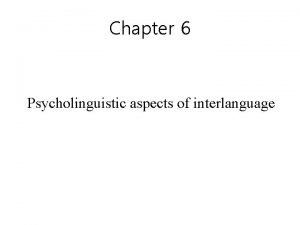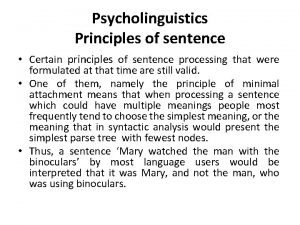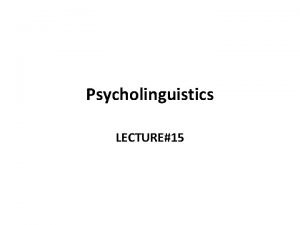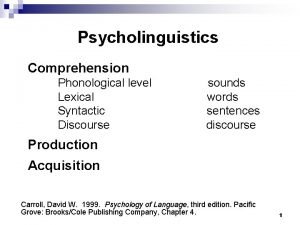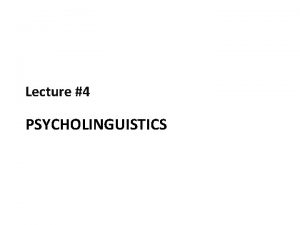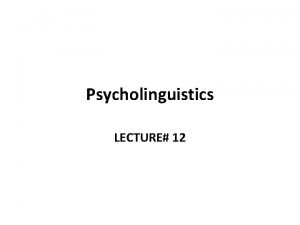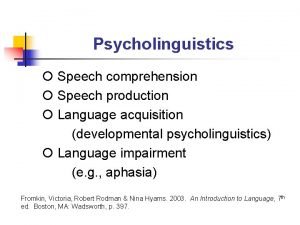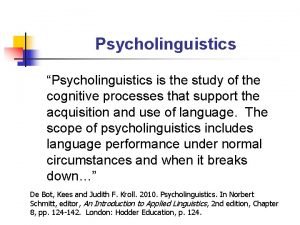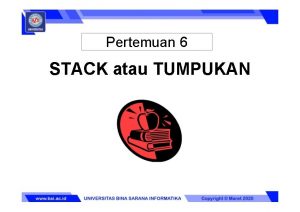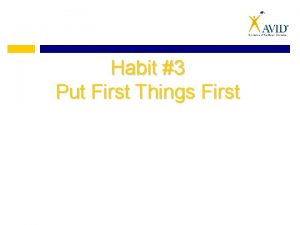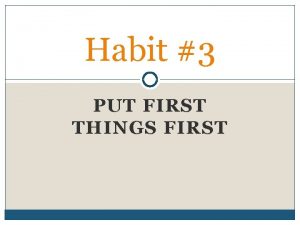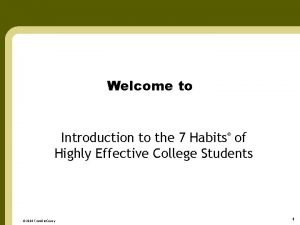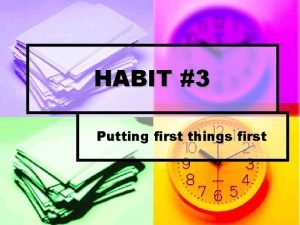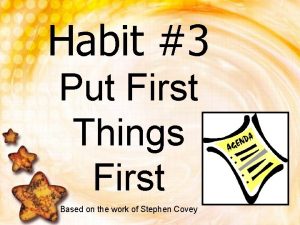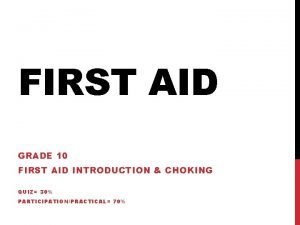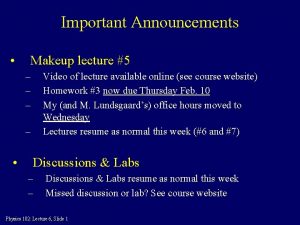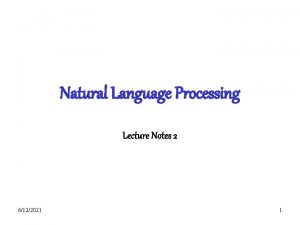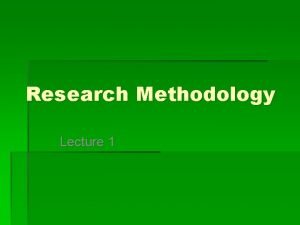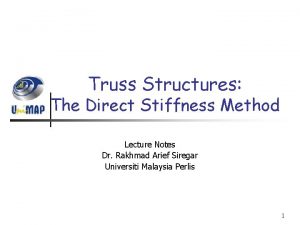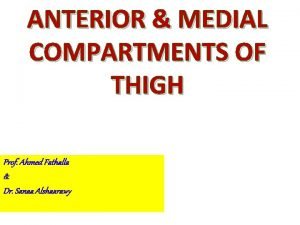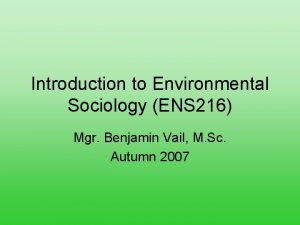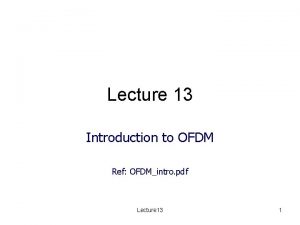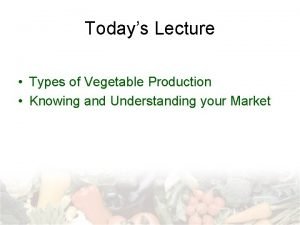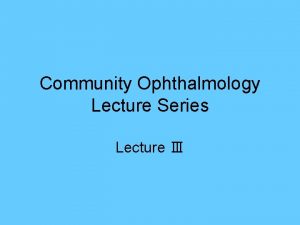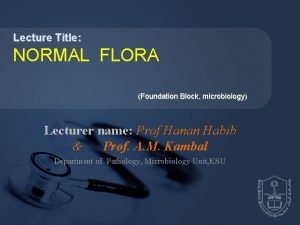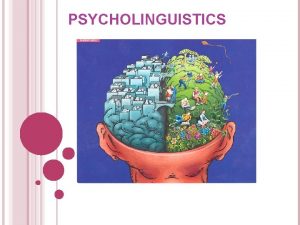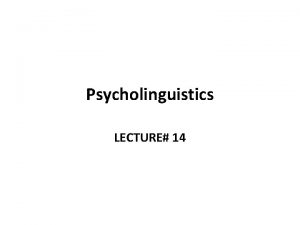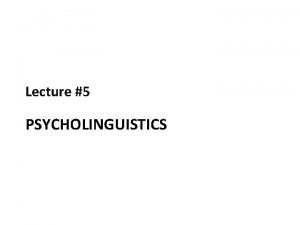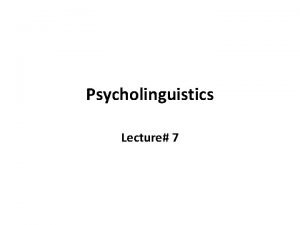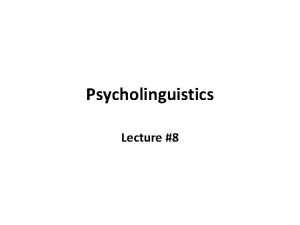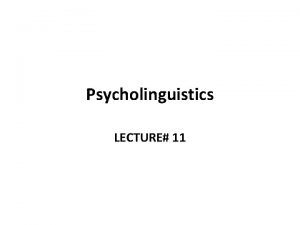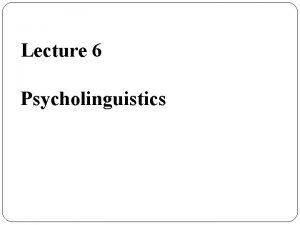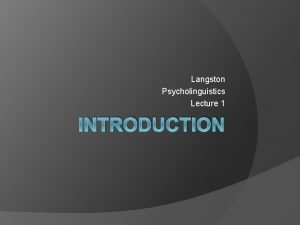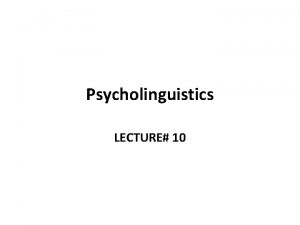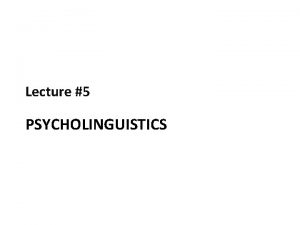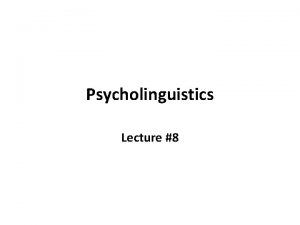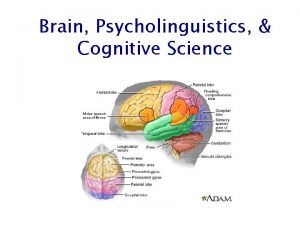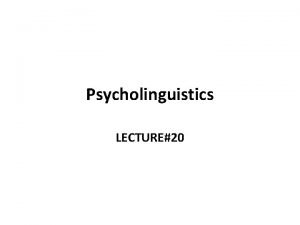Psycholinguistics LECTURE 13 Psycholinguistics Psycholinguistics Psycholinguistics Psycholinguistics First






































![Psycholinguistics Constraints on Speech Production Syllable deletion; e. g. animals [Qmz] Final consonant deletion; Psycholinguistics Constraints on Speech Production Syllable deletion; e. g. animals [Qmz] Final consonant deletion;](https://slidetodoc.com/presentation_image_h/0135cc18eac5e3a6bccb71f77ef7fda9/image-39.jpg)
























- Slides: 63

Psycholinguistics LECTURE# 13

Psycholinguistics

Psycholinguistics

Psycholinguistics

Psycholinguistics First Language Acquisition How Children Learn Language • Language Acquisition • Language acquisition is the process by which language develops in humans. • First language acquisition concerns the development of language in children • Second language acquisition focuses on language development in adults. • Historically, theories and theorists may have emphasized either nature or nurture as the most important explanatory factor for acquisition.

Psycholinguistics • Chomsky’s Universal Grammar • → children are born with a hard-wired language acquisition device (LAD) in their brains • → without an innate ability for language, human infants would be incapable of learning such complete speech patterns in a natural human environment

Psycholinguistics • Learning Condition of L 1 • The L 1 is picked up at home in the most natural situations, guided and controlled by those who are near and dear to a child, • The learning of L 1 takes place along with other aspects of biological growth such as walking • The learning of L 1 is governed by the principles of proximity, usefulness, concreteness, particularity and interest

Psycholinguistics • Factors Affecting L 1 Acquisition • Physical environment • → the material surroundings of a child, e. g. dog, house, cat, tree, table • Social environment • → family and neighborhood • Physical and economic resources • → the economical condition of the family

Psycholinguistics • Motivation • → internal: the need for food, warmth, shelter; constant care, love and affection • → external: social interaction, self expression, creative behavior • e. g. children sometimes talk to cat, dog or dolls

Psycholinguistics • An outstanding feature of the early language learning experience is egocentricity • → children only pick up language items that are absolutely essential for them • → the earliest pronouns: I, me, my, mine

Psycholinguistics • Stages of Language Acquisition • Pre-babbling • It is difficult to test children when they are first born. We can measure their interest in speech sounds by measuring their sucking rate. By doing this we have discovered that they come pre-equipped to head phonetic contrasts even for languages not spoken around them. • → the first cry of an infant functions as the crude starting point which makes possible all activities of the lungs and the speech organs

Psycholinguistics • Babbling • → sounds produced in the first few months after birth which include sounds that do and do not occur in the language of the household. • Even deaf children babble. They seem to be testing out their vocal apparatus, and perhaps tuning the articulation to their own audition. They babble with hand gestures similar to the vocal babbling of hearing children.

Psycholinguistics • Holophrastic • → refers to the one-word stage in which children produce one-word sentences (usually between 12 and 18 months) • At this stage utterances are one word long, though they often contain complex messages. Children have been shown to understand differences in word order at this stage even though they can't produce sentences with different word orders.

Psycholinguistics • Two-word stage • → around the beginning of the second year; children begin to produce sentences of two words with clear syntactic and semantic relations. • Most children go through a stage where sentences seem to be limited to two words. There can be a large variety of two-word patterns, however, and the sentences continue to encode much more complex meanings.

Psycholinguistics • Telegraphic speech • → utterances of children after the two-word stage when many grammatical morphemes are omitted • After the two-word stage there is an explosion in the child's capacity to form sentences, and developmental patterns are more difficult to describe. At this point it is better to simply test particular aspects and constructions from adult grammars to determine which aspects the children have acquired.

Psycholinguistics • Internalization of Linguistic System • The entire language learning is a process of internalization of systems. • Internalization of linguistic systems occurs at a variety of levels. • → an infant is bombarded by the language utterances of the people around

Psycholinguistics • • • • Random Articulation stimulated by the pleasurable experiences of the child, the main stimulus: reflex; produces non-distinctive sounds Auditory organs Internalization – an infant takes in whatever it can Production internalizes the basic sound system of a language: phonology; produces distinctive sounds Random Articulation stimulated by the pleasurable experiences of the child, the main stimulus: reflex; produces non-distinctive sounds Auditory organs Internalization – an infant takes in whatever it can Production Internalizes the basic sound system of a language: phonology; produces Getting familiar with the basic morphological sets of the language etc

Psycholinguistics • MLU • mean length of utterance • A measure used to refer to the number of words or morphemes in a child’s utterance • More accurate measure of acquisition stage than chronological age of child

Psycholinguistics Parentese & Baby Talk • Parentese • refer to the sort of speech which children receive when they are young • Characteristics: • • • - shorter syllables - parsing down words to phonemes - highly repetitive usage - raising pitch - slowing down the pace of speaking - simplifying the subject matter and sentence structure

Psycholinguistics • • About what? names for relatives good and bad behavior animal names eating sleeping bathroom matters

Psycholinguistics • Baby Talk • uses sounds and nonsense words • involves the use of vocabulary and syntax that is overly simplified and reduced • involves modification in vocabulary

Psycholinguistics Pre-birth • • Speech & Language Milestones 0 – 7 years old children Auditory skills begin to develop �Necessary for sound association • 0 - 6 months • Cooing and babbling; • Continual awareness of sound (turns to sound, stops crying when spoken to); • Uses eye gaze to indicate interest

Psycholinguistics • 7 – 12 months • First true words appear (they are often people, or nouns); • Same syllable is repeated (mama, dada); • Child demonstrates increased understanding of daily routines.

Psycholinguistics • 12 months • Child says 3 -5 words; • Child recognizes his/her name & understands simple instructions; • Initiates familiar words, gestures, and sounds; • Child understands common objects and actions (e. g. , cookie, eat, juice)

Psycholinguistics • 18 months • Child uses about 10 -20 words at age 18 months including names; • Recognition of pictures of familiar persons, objects‘ • Early 2 -word combinations of words emerge; • Needs are requested verbally such as "more, up"; • Child will point, gesture, follow simple commands, imitate simple actions, hum or sing; • Distinguishes print from non print.

Psycholinguistics 24 months (2 years) Child understands simple questions and commands; Identifies familiar actions/activities in pictures (i. e. "sleeping, eating"); Follows directions to put objects "on, off, in"; Puts two words together on average; Sentence length of up to three words; Child will refer to self by name; Labels pictures; Start to use the negative "not go"; Final "s" is used for plurals; Vocabulary jumps to 300 words during the year! In fact between the ages of 2 and 4, kids may increase their vocabulary to 2 words per day; • Children will stay with one activity about 6 -7 minutes. • • •

Psycholinguistics • • 30 months (2. 5 years) Child has about 450 word vocabulary; Child is able to give his/her first name; Child uses past tense, plurals, and combines nouns and verbs; Begin to identify objects from a group by their function and parts (ie. "which one has wheels? ", "which one can we eat? "); Begin to use verbs with "ing" endings (i. e. "eating"); Early concepts such as "big, little" are identified; Child will use "no, not" and answer "where" questions.

Psycholinguistics 3 years Child will name at least one color; Child will often talk during play, or when alone; Child can tell a basic story or idea; Child can use 3 -4 word sentences; Begins to understand "not"; Can identify items in a familiar category or group (i. e. "show me the animal"); • Child can have a vocabulary of up to 1000 words; • Children are often able to tell their name and street. • •

Psycholinguistics • 4 years • Child will follow 2 -3 step commands; • Child will ask many questions, including "who/why"; • Child talks in 4 -5 word sentences; • Understands and verbalizes spatial concepts more readily such as "on, under, next to. . "; • Child will talk in the past tense correctly.

Psycholinguistics • • • 5 years Child defines objects by their function; Identifies spatial concepts such as "on, behind"; Child uses 5 -6 word sentences; Child understands many opposites; Child can use different tenses (past, present, future), and many sentence types.

Psycholinguistics • 6 – 7 years • Child is developing phonological (sound/letter) awareness skills, and sound/word segmentation skills; • Can generate creative sentences; • Understands time/space concepts such as "before/after, first/second/last".

Psycholinguistics When to be concerned? Point to an object when it's named Recognize names of familiar people, objects and body parts Say about 50 words Use simple phrases by linking two words, such as "me up" (for "pick me up") • Use simple pronouns (he, she, me) and prepositions (with, by) • Most children are saying simple words, such as "mama" and "dada" by age 1. But it's important to remember that children vary greatly in their speech development. Even so, a doctor would likely be concerned if a 2 -year-old was not yet speaking. Children at this age can typically: • • •

Psycholinguistics • A child whose speech isn't progressing should be checked by a doctor. Speech delays occur in up to 10 percent of young children. Causes include: • Being a twin • Slow development • Mental retardation • Autism • In addition, children living in bilingual homes may experience some speech delays as they learn to interpret and use two languages. This is normal.

Psycholinguistics • THE ACQUISITION OF PHONOLOGY, MORPHOLOGY, SYNTAX, SEMANTIC, & DISCOURSE IN CHILDREN

Psycholinguistics • The Acquisition of Phonology • Early Perception: • By 1 -2 months of age (perhaps from birth) infants have the basic sensory capabilities to discriminate speech sounds → “High-Amplitude Sucking” • 6 months infants are able to discriminate any phonological contrast, independent of the surrounding language → “Visually reinforced head-turn” • Between the end of their first year and the beginning of their fifth year children learn to distinguish among words that differ in only a single segment. Infant perception starts to resemble adult perception

Psycholinguistics

Psycholinguistics • During the Preverbal Vocalization • (2 -4 months): mainly vocalic sounds, palatal, velar (resting place of tongue) – (rest of first year) Anatomical and neuromotor factors play a critical role during this development (vocal tract length, position of tongue, velum, neuromuscular control of the tongue) – Increased control of laryngeal (voicing) and oral articulatory mechanisms – Labial and dental sounds – Both periodic and aperiodic sounds – Pitch and loudness manipulated – Gradually babbling starts to resemble adult-like syllables: true consonant+vowel

Psycholinguistics • During the Second Year – General increase in use of true consonants labials more frequent than coronals – coronals more frequent than velars – stops, nasals more common – fricatives less frequent – they require more precise articulatory control – Vowels tend to be the basic “cardinal” vowels [i a u] CV is the preferred syllable structure – Omission of word final consonant – Omission of fricative or liquid in cluster – Early words consist of 1 or 2 syllables
![Psycholinguistics Constraints on Speech Production Syllable deletion e g animals Qmz Final consonant deletion Psycholinguistics Constraints on Speech Production Syllable deletion; e. g. animals [Qmz] Final consonant deletion;](https://slidetodoc.com/presentation_image_h/0135cc18eac5e3a6bccb71f77ef7fda9/image-39.jpg)
Psycholinguistics Constraints on Speech Production Syllable deletion; e. g. animals [Qmz] Final consonant deletion; e. g. because [pikÃ] Consonant harmony; e. g. yellow [l. Elo. U] Cluster reduction; e. g. pretty [pi�i], smile [sa. Il], blocks [baks] • Fronting of velars, palatals; e. g. cow [ta. U], show [so. U] • Stopping; e. g. move [mub], juice [dus] • Gliding; e. g. love [jÃv], red [w. Ed] • • •

Psycholinguistics Simplification Strategies Substitution; e. g. fis > fish Deletion: fish > ish Cluster reduction: spider > pider Metathesis: snow > nos Assimilation: dog > dod; duck > guck Chain shifts: truck as duck, duck as guck: substitution+assimilation • Avoidance: comprehends the word but avoids it in articulation • •

Psycholinguistics • Phonological idioms: Child words which do not follow the pattern of sound changes attested elsewhere in the child’s productions. • �Regression: a phonological idiom taking on a less mature form to become consistent with the rest of the system.

Psycholinguistics • Individual Variations in Acquiring Phonology • Whether the child’s earliest productions are segmentally detailed or whether they are better described as maintaining the suprasegmental pattern of the ambient language at the expense of phonological accuracy • Whether they avoid words which they cannot produce and as a result give relatively accurate renditions of the words they do produce, or whether they attempt many words, resulting in substantial deviations fro the adult forms.

Psycholinguistics

Psycholinguistics

Psycholinguistics • The Acquisition of Morphology • Word comprehension: mapping auditory form onto meanings (the concept of ‘here & now’ in parentese) • Children start to show knowledge of morphophonemic rules around age 4. • In English, children also “regularize” irregular forms

Psycholinguistics

Psycholinguistics • Lexicon Acquired • The principle of ‘here and now’ • Content words before function words • → nouns > verbs > adjectives • Basic level category: generic nouns • Overextension vs underextension

Psycholinguistics Strategies for Acquiring Lexicon Reference: everything has referents Object scope: the concept of bicycle Extendability: black cat? white cat? Categorial scope: hyponymy Novel name/nameless category: putting new words in the mental lexicon • Conventionality: use of familiar words • • •

Psycholinguistics • The Acquisition of Syntax • The stage of child language where it progresses from mere concatenation of lexical items to adult language • Child acquires morphosyntax – syntax & grammatical morphemes

Psycholinguistics • Learning a grammatical morpheme • How does it sound? (including allomorphs) • Where is it likely to occur in a sentence? (distribution) • What is it used for? (syntactic function)

Psycholinguistics

Psycholinguistics • The Acquisition of Semantics & Pragmatics • Communicative intents: egocentricism – Discourse Organization (in Conversation) Competence, maxims, rules – Speech acts – Conversational routines: opening, turn taking, closing – Conversational Exchange: Adjacency Pair, Question and Answer, Complex exchanges – Interactive Speech : Turn Taking, Simultaneous talk and Interruption

Psycholinguistics • Language and Communication • Animal Communication • Wild Children and Language

Psycholinguistics • Animal Communication • Animal communication is any behavior on the part of one animal that has an effect on the current or future behavior of another animal. • The study of animal communication → zoosemiotics • �Animal communication is a rapidly growing field, and even in the 21 st century so far, many prior understandings related to diverse fields such as personal symbolic name use, animal emotions, animal culture and learning, and even sexual conduct, long thought to be well understood, have been revolutionized.

Psycholinguistics • Intraspecies vs Interspecies Communication • The sender and receiver of a communication may be of the same species or of different species. • �The majority of animal communication is intraspecies (between two or more individuals of the same species). • �However, there are some important instances of interspecies communication (between two or more individuals of different species).

Psycholinguistics What is this bird doing? With whom does he communicate?

Psycholinguistics • • Interspecies Communication Prey to Predator to Prey Symbiotic Species

Psycholinguistics • Prey to Predator • warning coloration: species such as wasps that are capable of harming potential predators are often brightly colored, and this modifies the behavior of the predator, who either instinctively or as the result of experience will avoid attacking such an animal. Hoverflies are colored in the same way as wasps, and although they are unable to sting, the strong avoidance of wasps by predators gives the hoverfly some protection.

Psycholinguistics • mimicry • canines such as wolves and coyotes may adopt an aggressive posture, such as growling with their teeth bared, to indicate they will fight if necessary • rattlesnakes use their well-known rattle to warn potential predators of their poisonous bite.

Psycholinguistics • Sometimes, a behavioral change and warning coloration will be combined, as in certain species of amphibians which have a brightly colored belly, but on which the rest of their body is colored to blend in with their surroundings. When confronted with a potential threat, they show their belly, indicating that they are poisonous in some way. • �A more controversial example of prey to predator communication is stotting, a highly noticeable form of running shown by some antelopes such as Thomson's gazelle. In the presence of a predator; it has been argued that this demonstrates to the predator that the particular prey individual is fit and healthy and therefore not worth pursuing.

Psycholinguistics • Predator to Prey • Some predators communicate to prey in ways that change their behavior and make them easier to catch, in effect deceiving them. A well-known example is the angler fish, which has a fleshy growth protruding from its forehead and dangling in front of its jaws; smaller fish try to take the lure, and in so doing are perfectly placed for the angler fish to eat them.

Psycholinguistics • Symbiotic Species • Interspecies communication also occurs in various kinds of mutualism and symbiosis. For example, in the cleaner fish/grouper system, groupers signal their availability for cleaning by adopting a particular posture at a cleaning station.

Psycholinguistics • • Intraspecies Communication Forms of Communication Functions of Communication Evolution of Communication
 01:640:244 lecture notes - lecture 15: plat, idah, farad
01:640:244 lecture notes - lecture 15: plat, idah, farad Psycholinguistics
Psycholinguistics What is psycholinguistics
What is psycholinguistics Psychological aspects of interlanguage
Psychological aspects of interlanguage History of psycholinguistics
History of psycholinguistics What is the scope of psycholinguistics
What is the scope of psycholinguistics Rod ellis
Rod ellis Language loss in psycholinguistics
Language loss in psycholinguistics Comprehension of words in psycholinguistics
Comprehension of words in psycholinguistics Scope of psycholinguistics
Scope of psycholinguistics Scope of psycholinguistics
Scope of psycholinguistics Derivational theory of complexity
Derivational theory of complexity Psycholinguistics scope
Psycholinguistics scope Garden path sentence
Garden path sentence Language a
Language a Psycholinguistics
Psycholinguistics Psycholinguistic approach to second language acquisition
Psycholinguistic approach to second language acquisition Comprehender adalah
Comprehender adalah Language
Language Prinsip stack
Prinsip stack Put first things first definition
Put first things first definition Breadth first and depth first search
Breadth first and depth first search Put first things first video
Put first things first video Difference between code first and database first approach
Difference between code first and database first approach Put first things first
Put first things first First in first out
First in first out Fcfs calculator
Fcfs calculator Sdl first vs code first
Sdl first vs code first Put first things first activities
Put first things first activities First to file vs first to invent
First to file vs first to invent First come first serve
First come first serve See do get model 7 habits
See do get model 7 habits Habit 3 lesson plans
Habit 3 lesson plans First aid merit badge first aid kit
First aid merit badge first aid kit Stack declaration
Stack declaration Maturity continuum 7 habits
Maturity continuum 7 habits Habit 3 activities
Habit 3 activities Habit 3 first things first
Habit 3 first things first First aid in the first grade
First aid in the first grade Bmfp
Bmfp Makeup lecture
Makeup lecture Nlp lecture notes
Nlp lecture notes Lecture sound systems
Lecture sound systems Significance of research methodology
Significance of research methodology Introduction to algorithms lecture notes
Introduction to algorithms lecture notes Global stiffness matrix
Global stiffness matrix Financial engineering notes
Financial engineering notes Thigh
Thigh Environmental sociology examples
Environmental sociology examples Themes of othello
Themes of othello Land economics lecture notes
Land economics lecture notes Ofdm lecture notes
Ofdm lecture notes Contemporary issues in management ppt
Contemporary issues in management ppt Heart apex base
Heart apex base Operating system lecture notes
Operating system lecture notes Cloud computing lecture
Cloud computing lecture Power system dynamics and stability lecture notes
Power system dynamics and stability lecture notes Lost legions
Lost legions Résumé chapitre par chapitre tirez pas sur le scarabée
Résumé chapitre par chapitre tirez pas sur le scarabée Vegetable lecture
Vegetable lecture Mechatronics lecture notes / ppt
Mechatronics lecture notes / ppt Ophthalmology lecture
Ophthalmology lecture Data visualization lecture
Data visualization lecture Lecture title
Lecture title



